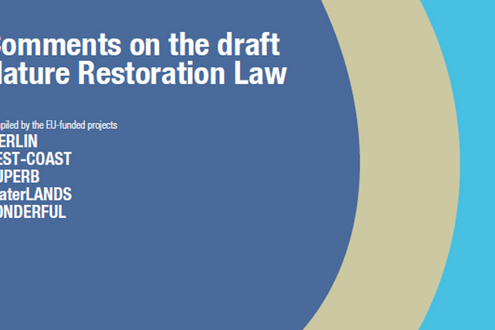What is the EU Nature Restoration Law?
The EU Nature Restoration Law is a proposal that requires EU Member States to restore ecosystems such as wetlands, forests and coastlines that have been degraded by human activity. It is an important element of the EU Biodiversity Strategy, which calls for binding targets to restore damaged ecosystems, in order to store carbon and prevent and mitigate the effects of climate change.
More than 80% of habitats are in unfavourable conservation status condition under the EU Habitats Directive, with bog, mire and fen habitats showing strong deteriorating trends. Europe needs a strong law for restoration because it is essential that we address and reverse the rapid and accelerating loss of the natural environment along with its precious wildlife, which underpins our health, economies and well-being.
The EU Nature Restoration Law, which will require Member States to develop national plans on restoration, has reached several milestones over the past weeks. As the Ordinary Legislative Procedure is ongoing, several proposals for the Law were tabled by EU Institutions, with different levels of ambition. While the European Commission set the initiative of the legislative proposal, readings of the co-legislators, the European Parliament and the Council have substantially modified the initial proposal of the Commission. The next steps of this process are the Trilogues, where EU institutions will aim to reach an agreed text, before formal adoption by EU Institutions. Here are the differences between them.
The European Commission (22nd June 2022)
The proposal for the EU Nature Restoration Law was initially introduced by the European Commission in June 2022. Their proposal would require EU member states to restore forests, wetlands, marine areas and other ecosystems damaged by human development. The proposal includes an overarching restoration objective for long-term recovery, with binding restoration targets for specific ecosystems. These measures would cover at least 20% of the EU's land and sea areas by 2030, and all ecosystems in need of restoration by 2050.
The European Council (20th June 2023)
In June 2023, the European Council presented it’s “general approach” a filtered version of the Commission's proposal, that comprises important targets for ecosystems including wetlands, but includes more flexibility for Member States, including on peatland restoration targets.
- The Council aligned the overall restoration objective and requirements for habitats restoration to the Kunming-Montreal Global Framework for Biodiversity;
- The ambition under article 9, on the restoration of agricultural land was lowered, including for the restoration percentages for peatlands restoration (Article 9.4), and importantly, the Council introduced wording that enables Member States to reduce the rewetting proportion of the initial peatland restoration target. River restoration targets have also been reduced, notably to favour the development of renewable energy, such as hydropower.
- The Council’s general approach also deleted provisions relating to access to justice but proposed to secure financing for the implementation of the legislation.
The European Parliament (12th July 2023)
In July 2023, the European Parliament passed a weaker version of the Law than what was proposed by the Commission and the Council. A "patchwork text" was proposed and includes problematic elements, notably:
- Restoration targets for habitats have been diluted by restricting the restoration of habitats to Natura 2000 sites for terrestrial, coastal, freshwater ecosystems and deleting the time-bound targets, which reduces the scope of the initial proposal;
- Art.9 on the restoration of agricultural land and its associated sub-articles have been deleted, including peatland restoration targets as well as biodiversity indicators;
- Several amendments have been added which delay the implementation of the NRL or offer to postpone the achievement of targets in case of “exceptional socio-economic” circumstances, delete the main provisions on access to justice. The Parliament supported a proposal to secure financing or the implementation of the legislation, while excluding the use of CAP funding.
Negotiations and next steps
Trilogue meetings on the Nature Restoration Law commenced on the 19th of July. The Trilogues are an informal but crucial negotiation forum where the co-legislators, the European Parliament and the Council, have to find a consensus to achieve a common position, with the European Commission acting as a sort of referee. The outcome of the Trilogue meetings will be a more harmonised text. The final version of the EU Nature Restoration Law is expected to be ready by the end of 2023.
To show support to the Nature Restoration Law, national government should be contacted directly as they are negotiating the Council’s position. Members of the European Parliament (MEPs) involved can also be contacted: the Parliament's rapporteur, César Luena, and shadow rapporteurs: Christine Schneider, Soraya Ramos, Jutta Paulus, Alexandr Vondra, Mick Wallace, or Pascal Canfin, chair of the ENVI Committee. They can all influence the Parliament’s position in the Trilogues. It is also useful to contact your own local MEP(s).
WaterLANDS is a Horizon 2020 Green Deal funded project that aims to restore degraded wetlands across Europe, as well as creating the means to upscale their protection across wider areas. WaterLANDS supports a strong Law to Restore Nature in Europe.


